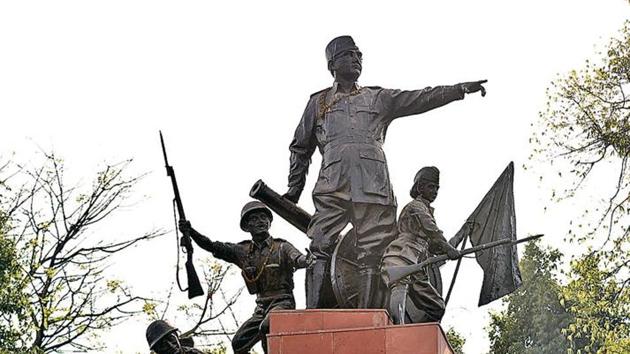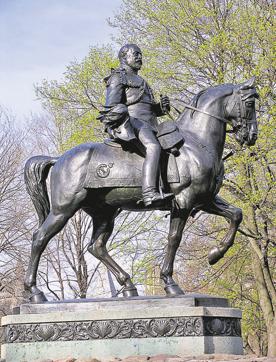Netaji Subhash Park in Old Delhi outlives names, statues
The park, that is nearly a century old, was first named after King Edward VII and later after the freedom fighter Subhash Chandra Bose. It has remained closed for almost 5 years due to Metro construction.
The historic Netaji Subhash Park in Old Delhi will return to life this year after having remained closed for almost five years due to Metro construction.

The park, that is nearly a century old, was first named after King Edward VII and later after the legendary freedom fighter Subhash Chandra Bose. It was once among the prime public recreation facilities that provided an ideal setting for leisure activities.
Elderly residents of the Walled City would spend hours at the park discussing politics. Travellers would find solace in the company of tall palm and locals would get a traditional massage from ‘malishya’ under the shadow of narangi trees.
About six years ago, the Delhi Metro Rail Corporation (DMRC) had taken over this municipal park to build underground tunnel for the Heritage Line connecting Mandi House and Kashmere Gate. In the run up to the construction of Jama Masjid Metro station, the green park was dug up and the statue of Bose flanked by his INA compatriots was removed. The work on the Metro corridor was completed last year after which the work to restore the park was started.
The Metro has now asked the North Delhi Municipal Corporation to take charge of the park. “We have restored the lawn and statues. The work on footpath and jogging track was completed almost a year ago. We have written to the MCD for handover a few times,” said a Delhi Metro official, privy to the development.
He blamed the corporation for not responding to DMRC’s formal communication. However, the north Municipal Corporation said the handover could not be done as work in still incomplete.
“Lamps have not been installed. Water pipeline and walkways are to be laid by the Metro. Recently, their engineers had a joint inspection with our officials. They have asked for the site plan, which has been provided. We are hoping that soon the park would be ready for public,” said DN Sharma, deputy director, (horticulture) of City-Sadar Paharganj Zone.
Edward memorial to Subhash park
Subhash Park was established in the memory of King Edward VII as a sign of the increasing British domination in the subcontinent. King George V laid the foundation of the park in December 1911 when he came to Delhi for Coronation Durbar. Edward VII’s equestrian statue crafted by famous English sculptor Thomas Brock, who designed London’s Queen Victoria Memorial, was the center of attraction at the park. The statue showed the king riding a horse in his uniform as a field marshal, holding his plumed hat in his left hand.
Remembering his frequent visits to Subhash Park during 1940-60s, author and photographer Dhruva N Chaudhuri said the British monarch’s 5-tonne installation was the only equestrian statue in Delhi at that time. “It was a huge bronze statue, made abroad, which cost ₹5 lakh. The park was a quiet place and offered a fantastic view of Jama Masjid. Unfortunately, the palm trees that surrounded the statue have been cut down,” he said.
The park was inaugurated as the All-India King Edward Memorial by Prince of Wales Edward VIII in February 1922.
“It was also called ‘Ghodewala (horse) Park’ and ‘Yadgaar (remembrance) Park’. They sat around the statue surrounded by palm trees. It was a daily ritual of sorts. A newspaper was placed on the ground and roasted grams were put on it and politics was discussed,” said 80-year-old Haji Mian Fayazuddin, an old resident of Jama Masjid area.
Change of statues
In 1960s, when the government decided to remove all British colonial statues in the city following pressure from socialist leaders, the bronze figure was shifted to Coronation Park with other statues. Later, it was bought by a Canadian businessman and placed at Queen’s Park in Toronto in 1969.
“When I visited Toronto in early 1970s, I saw Edward’s statue there. When I inquired, I was told it was the same that was once at Subhash Park in Delhi,” said senior Bharatiya Janata Party (BJP) leader Prof Vijay Kumar Malhotra, who was chief executive councillor of Delhi’s Metropolitan Council (during 1967-72), a post equivalent to chief minister.

An ensemble of Subhash Chandra Bose and INA soldiers was mounted at the park on January 23, 1975 on the birth anniversary of the freedom fighter. The then vice-president, Basappa Danappa Jatti, unveiled the statues created by the famous artiste Sadashiv Sathe.
Fayazuddin said King Edward’s statue was dislodged early in the morning to avoid any disturbance. He said initially the administration took good care of the statues of Bose and INA fighters.
“It was washed every Friday. A person would come with a piece of cloth and a ladder to clean them. It is unfortunate that we don’t care about them anymore. All of them are covered in a thick layer of dust and droppings,” Fayazuddin said.
Edward Park and freedom struggle
The land where the park now stands is believed to have been the site of Shah Waliullah’s madrasa and an adjacent mosque, popularly known as Akbarabadi mosque. Some academics believe the mosque was built during Mughal emperor Shahjahan’s reign and was named after one of his wives Begum Aza-un-Nisa also known as Akbarabadi Begum.
The path between Jama Masjid’s eastern gate and Lal Quila’s Dilli Gate also had a market called Khas Bazaar. Several noblemen under the Mughal rule had built their mansions in this area. The bazaar was popular for preachers, quacks, professional storytellers, vendors, and entertainers. These shops, residential quarters, and the mosque are said to have been razed after the British regained the control of the city after the revolt of 1857.
“The best view I could find of Jama Masjid was from Edward Park. That was where the grand Akbarabadi mosque was demolished in the clean-up around the Red Fort. However, an old photograph taken by an English photographer called Beato in 1858 from the of the Jama Masjid clearly shows the presence of this mosque,” Chaudhari says in his book ‘Delhi: Light, Shades, Shadows’.
In her book ‘Chandni Chowk: The Mughal City of Old Delhi’, Intach convener Swapna Liddle too writes that the markets and residential buildings in the vicinity of Jama Masjid and Lal Quila were demolished after 1857 revolt. “Many important localities and buildings were sacrificed to the clearance, including the Akbarabadi Mosque,” the book says.
The idea of the demolition was to have an unobstructed view of the mosque and its neighbourhood from the Red Fort as the British considered it the venue where rebels congregated and created mischief.
The Akbarabadi mosque site was converted into Edward Park in 1922. Later, it was divided and renamed as Subhash Park, Urdu Park, and Dangal Maidan after the Independence.
“Before Independence, political meetings were organised in the neighbouring Urdu Park. Several Congress and Muslim League leaders such as Maulana Azad, Jawaharlal Nehru, Maulana Ata Ullah Shah Bukhari of Multan, Muhammad Ali Jinnah, and Liaquat Ali used to hold meeting here during the freedom struggle,” said Fayazuddin.
Stay updated with all top Cities including, Bengaluru, Delhi, Mumbai and more across India. Stay informed on the latest happenings in World News along with Delhi Election 2025 and Delhi Election Result 2025 Live, New Delhi Election Result Live, Kalkaji Election Result Live at Hindustan Times.
Stay updated with all top Cities including, Bengaluru, Delhi, Mumbai and more across India. Stay informed on the latest happenings in World News along with Delhi Election 2025 and Delhi Election Result 2025 Live, New Delhi Election Result Live, Kalkaji Election Result Live at Hindustan Times.






